Radar Detector Situations
On the road, Valentine One gives you far more information about radar than any other radar detector. Still, to achieve the best defense, you must interpret this information correctly. The following examples will help you get maximum protection.
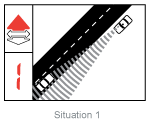
Situation 1: You are driving toward a radar aimed at you.
Your Warning: The Ahead arrow will glow. The Bogey Counter will show 1. You’ll hear a slow Beep for X band or Brap for other radars. As you come close to the radar, the Beeps (or Braps) will become more frequent until they merge into a continuous tone. By this time you should see the radar.
The Beside arrow and then the Behind arrow will glow as you pass the radar.
In this situation, moving radar and stationary radar will give the same alert, except the Beep rate will increase faster with moving radar because the closing speed is greater.
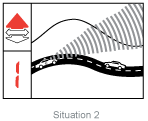
Situation 2: You’re driving on a hilly road. Radar is waiting over the next hill.
Your Warning: Well before you reach the hilltop, the Ahead arrow will glow. The Bogey Counter will show 1. You’ll hear a slow Beep or Brap, and the rate will increase very quickly as you near the hilltop. As soon as you can see over the hill, you will probably spot the radar.
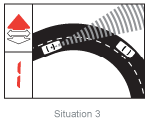
Situation 3: You’re driving on a curvy road. Radar is waiting around the next curve.
Your Warning: The Ahead arrow will glow (because the radar is forward, not to the side, of your car). The Bogey Counter will show 1. You’ll hear a slow Beep or Brap, and the rate will increase very quickly as you turn the corner. You should see the radar as soon as you’re around the corner.
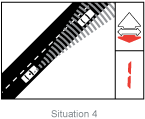 Situation 4: You’re driving down the highway and moving radar is coming up behind you.
Situation 4: You’re driving down the highway and moving radar is coming up behind you.
Your Warning: The Behind arrow will glow. The Bogey Counter will show 1. You’ll hear a slow Beep or Brap, and the rate will increase very slowly. This sort of alert could last for miles because the closing rate is just a few mph. Finally, if you watch your mirrors, you’ll see the radar. To mute the audio at any time, press the Control Knob.
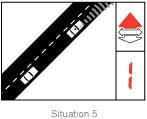 Situation 5: You’re driving down the highway and closing on a moving radar ahead of you that’s going in your direction.
Situation 5: You’re driving down the highway and closing on a moving radar ahead of you that’s going in your direction.
Your Warning: The Ahead arrow will glow. The Bogey Counter will show 1. You’ll hear a slow Beep or Brap that increases very slowly. As in Situation 4, your closing rate is very slow, so this alert could last for a long time.
Whenever you encounter an alert that lasts for an abnormally long time, it’s probably radar moving along at about your speed. To mute the audio at any time, press the Control Knob.
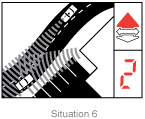 Situation 6: You’re driving a route where you expect a burglar alarm, but this time there’s radar hiding under the cover of the normal alert.
Situation 6: You’re driving a route where you expect a burglar alarm, but this time there’s radar hiding under the cover of the normal alert.
Your Warning: The Ahead arrow will glow. You’ll hear the usual Beep or Brap if you detect the burglar alarm, possibly (but not necessarily) a different sound if the radar is detected first. But when you hear the Bogey Lock (“Dee-Deet”) warning, that’s a sure indication that this situation is more threatening. The Bogey Lock warning is given whenever Valentine One locks onto an additional threat. In this case, the Bogey Counter will show 2, confirming the second threat. If the radar is X band, same as the burglar alarm, you will hear a slow Beep; it may strengthen faster than normal. If the radar is on one of the other frequencies, the audio will correspond to the bogey that the computer has determined to be most dangerous.
The key thing to remember is, any time you detect more bogeys than normal, watch out.
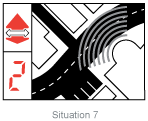 Situation 7: You’re driving through a metro area with the usual number of burglar alarms and microwave door openers.
Situation 7: You’re driving through a metro area with the usual number of burglar alarms and microwave door openers.
Your Warning: Because these signals are usually weak, you’ll get slow Beep or Brap (if you hear Bra-Brap, the warning for Ka band, it’s probably radar). The Ahead arrow will quickly pass to the side. Or your first alert may be to the side. These alarms are usually located well off the road.
You may also encounter overlapping alarms. During an alert, you’ll hear Bogey (“Dee-Deet”) Lock each time an additional bogey is detected. The Bogey Counter shows the total, which, in the case of overlapping alarms, will be 2 or more. If they are in different directions, more than one direction arrow will glow. When multiple directions are being monitored, the computer will decide which is most dangerous and that one will be indicated by a flashing arrow. The audio warning will correspond to that bogey.
The key thing to remember about non-radar alarms on X band is this: they’re weak and they pass to the side quickly. If you find a strong one Ahead, it’s probably radar. You can minimize the annoyance of these X-band alarms by selecting Logic® or Advanced-Logic® modes. See Controls & Functions (pages 15 and 16).
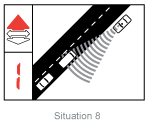 Situation 8: You’re driving down the highway and Instant-on radar is operating nearby.
Situation 8: You’re driving down the highway and Instant-on radar is operating nearby.
Your Warning: The first thing you’ll notice will be “Beeeee”, or “Braaaaa” because the radar encounter will start instantly at high strength. If the radar is ahead, then the Ahead arrow will glow. Probably the radar is aimed in your direction, but maybe not. It might be aimed the same way you’re going, zapping oncoming cars as they approach and ready to shoot you in the back after you’ve passed. In either case, watch out.
If the Behind arrow glows simultaneously with the “Beeeee” or “Braaaaa”, probably you are being shot in the back.
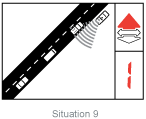 Situation 9: You’re driving down a highway and Instant-on radar — a long way ahead — is zapping traffic as it passes.
Situation 9: You’re driving down a highway and Instant-on radar — a long way ahead — is zapping traffic as it passes.
Your Warning: The Ahead arrow will glow. The Bogey Counter will show 1. You’ll hear a very slow Beep or Brap that will last just 3-5 seconds. Then the alerts ends.
What happens next depends on traffic and terrain. If there’s light or medium traffic between you and the radar, you’ll hear the same pattern again, maybe repeated several times, as the radar zaps each car ahead in turn. If you hear this pattern, watch out.
If there’s no traffic within sight ahead, watch out, because you could be next.
With ordinary detectors, short, weak alerts are usually shrugged off as false alarms, leading the motorist to drive right into an Instant-on trap. The Radar Locator is critical to your defense in this circumstance. If it points off to the side, the bogey is not a threat. But if it points ahead, watch out.
